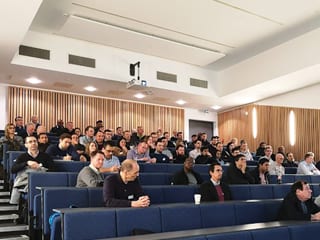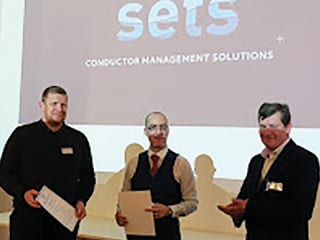The branch held its 5th event of the 19/20 season at RGU Aberdeen, with a paper entitled “Structural Integrity Issues: under-deck, air-gap, splash zone assessment / deterioration / repair mechanisms, (for corroded / fatigued conductors, caissons and risers)” by Chris Tierney, SETS. This was a highly successful 1st joint presentation with EI – The Energy Institute, with
75 attendees.
The first part of the presentation considered, conductor integrity, hidden risks and corrosion mitigation, and in the second part Chris discussed new platform-launched technologies for repair of caissons and conductors subsea on ageing assets. After a decade in the subsea engineering sector with Technip, Chevron Upstream Europe, and Pro Dynamic Lifting (PDL), Chris founded SETS in 2011 as a subsea engineering and consultancy specialist. A platform splash zone is an area of multiple risks to production due to the high likelihood of mechanical damage to elements running through this area, cracking and in some geographical locations, very high corrosion rates. SETS provide innovative, engineering and tooling services to deliver efficient conductor management and repair solutions. The company have continued to innovate, learn and produce solutions for this difficult work zone and have been at the forefront of the design and development of technically advanced subsea tooling for conductor cleaning and inspection, clamp repair and shim installation. Unusually, their technology is remotely operated from topside, eliminating the requirement for diver support, and dramatically reducing time and cost. Their success in this area has resulted in the recent acquisition of the company by AquaTerra ( Kintore, Aberdeenshire).
The SETS presentation concentrated on conductors but the technology is equally applicable to caissons and risers. Conductors run from seabed to wellhead, providing environmental protection to the most vulnerable well components. A conductor should be considered a complex system, and its integrity managed accordingly, spanning wells, structural and operational functions. The condition of conductor and guide frames at the spider deck reflect the condition of these at the first elevation subsea. These are the most highly utilised areas in a conductor system, subjected to the greatest environmental loads and generally where majority of defects present themselves. The presentation discussed in detail, marine corrosion, fretting, fatigue, damage mechanisms and progression rates affecting conductors on ageing assets. Chris explained how different marine environments worldwide impact on conductor, caisson and riser integrity and following this, there were many thoughtful questions from the audience.

A full house, attended this first IE/ICorr joint event.

Branch chair, Stephen Tate, closes the event with Certificates of Appreciation to Roy Milne (Vice Chair of EI – Energy Institute and Chris Tierney, Managing Director of SETS.
The February 2020 evening meeting with 55 attendees opened with a discussion of the new ICorr logo and re-branding of the Institute to provide a much needed re-start and more professional focus, with the key being firmly on corrosion prevention by all available means. Following this introduction, there were very informative twin presentations by DNV-GL on risk based inspection activities, covering both PSVs (Pressure Safety Valves) and FPSO’s (Floating Production, Storage and Offloading) units.
The first presentation, by Dr Chris Bell discussed how data analysis of servicing has helped reduce cost and improve safe interval servicing of PSVs. PSVs are installed in process and utility systems to prevent build-up of internal pressure, or external effects such as fire. Over pressurisation of any vessel, or other equipment item, with energy released from the pressurised fluid, or the hazardous or flammable nature of the contents, can have significant consequences on a platform. Valves can block through build-up of wax, gunk or corrosion products within the system and the PSV will fail to lift. For this reason, PSVs are classed as safety critical when protecting hydrocarbon containing equipment and must be safety tested on a regular basis. The testing cannot generally be done in-situ, and valves most usually have to be taken onshore, tested, refurbished and refitted. Typically there are over 100 PSVs on a platform so it is worth optimising the maintenance interval. This can be done by data analysis to find the appropriate time to service the valve based on previous history and ensure a safe practice whilst minimising costs, and the inspection interval can be set so that the residual risk of failure is acceptable.
0.5 billion hours of service data for PSVs have been analysed from 10,311 tests and 544 failures by DNV-GL to allow optimisation of maintenance intervals and manage the inspection of PSVs. A methodology was developed that combined qualitative and quantitative RBI analysis. This multi-layered assessment gained the most information possible from the data, and as an outcome, the average maintenance interval was changed from 37 to 44 months and the test failure rate dropped. So, for an average PSV maintenance cost of £1000, total cost has now reduced by £ 1.1m from £6.5m to £5.4m per year.
The second presentation was by Dr Madhu Parlapalli, who presented a paper on risk based inspection (RBI) of FPSO Cargo Tanks. Risk based inspection in the oil and gas industry of piping, pressure vessels and other critical equipment has been used more recently for planning structural inspections. For floating structures like FPSOs where there are additional requirements to satisfy in the form of Classification Society rules, although risk based approaches are allowed under these rules there are relatively few examples of where this has been applied to plan structural inspections on FPSOs, for items such as cargo or ballast tanks.
It is operationally quite inconvenient to carry out inspections of these tanks on a fixed 5-year interval in line with a standard Class schedule. A risk based inspection schedule has to take account of all relevant degradation mechanisms and the corresponding means of inspection. For FPSO cargo tanks the main degradation threats are fatigue cracking and corrosion / coating degradation and of course general inaccessibility for inspection. The RBI process involves developing a structural hierarchy of ‘accessible’ elements, identifying the relevant ‘failure modes’ and damage mechanisms then evaluating the ‘probability’ ranking for the relevant mechanism. The ‘consequence’ ranking for safety, environment or business impact is then added, and the risk level is evaluated using an agreed risk matrix with the client/owner. An inspection plan can then be developed for different inspection activities to form an optimised inspection schedule. Case studies were presented for ‘hotspots’ identified on an FSPO and RBI analysis used to look at the fatigue degradation mechanism and a coating degradation mechanism. An extensive Q&A followed these 2 excellent papers.

Branch chair, Stephen Tate with Dr Chris Bell and Dr Mahdu Parlapalli of DNV-GL.
Full details of future branch events can be found on the diary page of this magazine and on the website, or by contacting: ICorrABZ@gmail.com. Copies of the majority of past branch presentations can be found at: https://sites.google.com/site/icorrabz/resource-center, and a photo gallery for all Aberdeen events can be found at: https://sites.google.com/site/icorrabz/event-gallery
A special reminder is drawn to the August 2020 Annual Corrosion Forum (ACF), which unfortunately has now been cancelled owing to the Covid.19 outbreak and knock-on financial effects.



